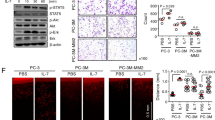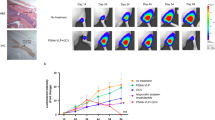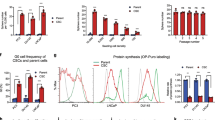Abstract
We have previously reported that adenoviral vector-mediated interferon (IFN)-β gene therapy inhibits orthotopic growth of human prostate cancer cells in nude mice. The purpose of this study was to determine efficacy and mechanisms of this therapy in immune-competent mice. TRAMP-C2Re3 mouse prostate cancer cells infected with 100 multiplicity of infection (MOI) of adenoviral vector encoding for mouse IFN-β (AdmIFN-β), but not AdE/1 (a control adenoviral vector), produced approximately 60 ng/105 cells/24 h of IFN-β. The tumorigenicity of AdmIFN-β-transduced cells was dramatically reduced in the prostates of C57BL/6 mice. A single intratumoral injection of 2 × 109 PFU (plaque-forming unit) of AdmIFN-β inhibited tumor growth by 70% and prolonged survival of tumor-bearing mice. Intriguingly, this AdmIFN-β therapy did not alter the growth of tumors in inducible nitric oxide synthase (iNOS)-null C57BL/6 mice. Immunohistochemical analysis revealed that treatment of tumors with AdmIFN-β in wild-type C57BL/6 mice led to increased iNOS expression, decreased microvessel density, decreased cell proliferation, and increased apoptosis. Furthermore, quantitative reverse-transcriptional PCR analysis showed that AdmIFN-β therapy, in C57BL/6 but not the iNOS-null counterparts, reduced levels of the mRNAs for angiopoietin, basic fibroblast growth factor, matrix metalloproteinase-9, transforming growth factor-β1, vascular endothelial growth factor (VEGF)-A, and VEGF-B, as well as the antiapoptotic molecule endothelin-1. These data indicated that IFN-β gene therapy could be effective alternative for the treatment of locally advanced prostate cancer and suggest an obligatory role of NO in IFN-β antitumoral effects in vivo.
This is a preview of subscription content, access via your institution
Access options
Subscribe to this journal
Receive 12 print issues and online access
$259.00 per year
only $21.58 per issue
Buy this article
- Purchase on Springer Link
- Instant access to full article PDF
Prices may be subject to local taxes which are calculated during checkout




Similar content being viewed by others
References
Lokshin A, Mayotte JE, Levitt ML . Mechanism of interferon beta-induced squamous differentiation and programmed cell death in human non-small-cell lung cancer cell lines. J Natl Cancer Inst 1995; 87: 206–212.
Belhumeur P, Lanoix J, Blais Y, Forget D, Steyaert A, Skup D . Action of spontaneously produced beta interferon in differentiation of embryonal carcinoma cells through an autoinduction mechanism. Mol Cell Biol 1993; 13: 2846–2857.
Qin XQ, Runkel L, Deck C, DeDios C, Barsoum J . Interferon-beta induces S phase accumulation selectively in human transformed cells. J Interferon Cytokine Res 1997; 17: 355–367.
Clemens MJ . Interferons and apoptosis. J Interferon Cytokine Res Jun 2003; 23: 277–292.
Biron CA . Interferons alpha and beta as immune regulators – a new look. Immunity 2001; 14: 661–664.
Albini A, Marchisone C, Del Grosso F, Benelli R, Masiello L, Tacchetti C et al. Inhibition of angiogenesis and vascular tumor growth by interferon- producing cells: a gene therapy approach. Am J Pathol 2000; 156: 1381–1393.
Singh RK, Gutman M, Bucana CD, Sanchez R, Llansa N, Fidler IJ . Interferons alpha and beta down-regulate the expression of basic fibroblast growth factor in human carcinomas. Proc Natl Acad Sci USA 1995; 92: 4562–4566.
Yamamoto S, Yasui W, Kitadai Y, Yokozaki H, Haruma K, Kajiyama G et al. Expression of vascular endothelial growth factor in human gastric carcinomas. Pathol Int 1998; 48: 499–506.
Einhorn S, Grander D . Why do so many cancer patients fail to respond to interferon therapy? J Interferon Cytokine Res 1996; 16: 275–281.
Ferrantini M, Belardelli F . Gene therapy of cancer with interferon: lessons from tumor models and perspectives for clinical applications. Semin Cancer Biol 2000; 10: 145–157.
Alizadeh H, Howard K, Mellon J, Mayhew E, Rusciano D, Niederkorn JY . Reduction of liver metastasis of intraocular melanoma by interferon-beta gene transfer. Invest Ophthalmol Vis Sci 2003; 44: 3042–3051.
Odaka M, Sterman DH, Wiewrodt R, Zhang Y, Kiefer M, Amin KM et al. Eradication of intraperitoneal and distant tumor by adenovirus-mediated interferon-beta gene therapy is attributable to induction of systemic immunity. Cancer Res 2001; 61: 6201–6212.
Kruklitis RJ, Singhal S, Delong P, Kapoor V, Sterman DH, Kaiser LR et al. Immuno-gene therapy with interferon-beta before surgical debulking delays recurrence and improves survival in a murine model of malignant mesothelioma. J Thorac Cardiovasc Surg 2004; 127: 123–130.
Kobayashi N, Kuramoto T, Chen S, Watanabe Y, Takakura Y . Therapeutic effect of intravenous interferon gene delivery with naked plasmid DNA in murine metastasis models. Mol Ther 2002; 6: 737–744.
Hendren SK, Prabakaran I, Buerk DG, Karakousis G, Feldman M, Spitz F et al. Interferon-beta gene therapy improves survival in an immunocompetent mouse model of carcinomatosis. Surgery 2004; 135: 427–436.
Streck CJ, Ng CY, Zhang Y, Zhou J, Nathwani AC, Davidoff AM . Interferon-mediated anti-angiogenic therapy for neuroblastoma. Cancer Lett 2005; 228: 163–170.
Streck CJ, Zhang Y, Miyamoto R, Zhou J, Ng CY, Nathwani AC et al. Restriction of neuroblastoma angiogenesis and growth by interferon-alpha/beta. Surgery 2004; 136: 183–189.
Lu W, Fidler IJ, Dong Z . Eradication of primary murine fibrosarcomas and induction of systemic immunity by adenovirus-mediated interferon beta gene therapy. Cancer Res 1999; 59: 5202–5208.
Lu W, u J, Kim LS, Bucana CD, Donawho C, He J et al. Active specific immunotherapy against occult brain metastasis. Cancer Res 2003; 63: 1345–1350.
Nathan C . Nitric oxide as a secretory product of mammalian cells. FASEB J 1992; 6: 3051–3064.
Bohle DS . Pathophysiological chemistry of nitric oxide and its oxygenation by-products. Curr Opin Chem Biol 1998; 2: 194–200.
Kourembanas S, McQuillan LP, Leung GK, Faller DV . Nitric oxide regulates the expression of vasoconstrictors and growth factors by vascular endothelium under both normoxia and hypoxia. J Clin Invest 1993; 92: 99–104.
Tuder RM, Flook BE, Voelkel NF . Increased gene expression for VEGF and the VEGF receptors KDR/Flk and Flt in lungs exposed to acute or to chronic hypoxia. Modulation of gene expression by nitric oxide. J Clin Invest 1995; 95: 1798–1807.
Stuehr DJ . Mammalian nitric oxide synthases. Biochim Biophys Acta 1999; 1411: 217–230.
Cao G, Su J, Lu W, Zhang F, Marteralli D, Zhao G et al. Adenovirus-mediated interferon-beta gene therapy suppresses growth and metastasis of human prostate cerin nude mice. Cancer Gene Ther 2001; 8: 497–505.
Ozawa S, Lu W, Bucana CD, Kanayama HO, Shinohara H, Fidler IJ et al. Regression of primary murine colon cancer and occult liver metastasis by intralesional injection of lyophilized preparation of insect cells producing murine interferon-beta. Int J Oncol 2003; 22: 977–984.
Zhang F, Lu W, Dong Z . Tumor-infiltrating macrophages are involved in suppressing growth and metastasis of human prostate cancer cells by INF-beta gene therapy in nude mice. Clin Cancer Res 2002; 8: 2942–2951.
DeLisser HM, Newman PJ, Albelda SM . Molecular and functional aspects of PECAM-1/CD31. Immunol Today 1994; 15: 490–495.
Mathews MB, Bernstein RM, Franza Jr BR, Garrels JI . Identity of the proliferating cell nuclear antigen and cyclin. Nature 1984; 309: 374–376.
Caminschi I, Lucas KM, O'Keeffe MA, Hochrein H, Laabi Y, Kontgen F et al. Molecular cloning of F4/80-like-receptor, a seven-span membrane protein expressed differentially by dendritic cell and monocyte-macrophage subpopulations. J Immunol 2001; 167: 3570–3576.
Foster BA, Gingrich JR, Kwon ED, Madias C, Greenberg NM . Characterization of prostatic epithelial cell lines derived from transgenic adenocarcinoma of the mouse prostate (TRAMP) model. Cancer Res 1997; 57: 3325–3330.
Dong Z, Greene G, Pettaway C, Dinney CP, Eue I, Lu W et al. Suppression of angiogenesis, tumorigenicity, and metastasis by human prostate cancer cells engineered to produce interferon-beta. Cancer Res 1999; 59: 872–879.
Zhang F, Lee J, Lu S, Pettaway CA, Dong Z . Blockade of transforming growth factor-beta signaling suppresses progression of androgen-independent human prostate cancer in nude mice. Clin Cancer Res 2005; 11: 4512–4520.
Muller PY, Janovjak H, Miserez AR, Dobbie Z . Processing of gene expression data generated by quantitative real-time RT-PCR. Biotechniques 2002; 32: 1372–1374, 1376, 1378–1379.
Singh RK, Gutman M, Llansa N, Fidler IJ . Interferon-beta prevents the upregulation of interleukin-8 expression in human melanoma cells. J Interferon Cytokine Res 1996; 16: 577–584.
Fabra A, Nakajima M, Bucana CD, Fidler IJ . Modulation of the invasive phenotype of human colon carcinoma cells by organ specific fibroblasts of nude mice. Differentiation 1992; 52: 101–110.
Kato N, Nawa A, Tamakoshi K, Kikkawa F, Suganuma N, Okamoto T et al. Suppression of gelatinase production with decreased invasiveness of choriocarcinoma cells by human recombinant interferon beta. Am J Obstet Gynecol 1995; 172: 601–606.
Sica G, Fabbroni L, Castagnetta L, Cacciatore M, Pavone-Macaluso M . Antiproliferative effect of interferons on human prostate carcinoma cell lines. Urol Res 1989; 17: 111–115.
Johns TG, Mackay IR, Callister KA, Hertzog PJ, Devenish RJ, Linnane AW . Antiproliferative potencies of interferons on melanoma cell lines and xenografts: higher efficacy of interferon beta. J Natl Cancer Inst 1992; 84: 1185–1190.
Wong VL, Rieman DJ, Aronson L, Dalton BJ, Greig R, Anzano MA . Growth-inhibitory activity of interferon-beta against human colorectal carcinoma cell lines. Int J Cancer 1989; 43: 526–530.
Xie K, Huang S, Dong Z, Juang SH, Gutman M, Xie QW et al. Transfection with the inducible nitric oxide synthase gene suppresses tumorigenicity and abrogates metastasis by K-1735 murine melanoma cells. J Exp Med 1995; 181: 1333–1343.
Nelson JB, Udan MS, Guruli G, Pflug BR . Endothelin-1 inhibits apoptosis in prostate cancer. Neoplasia 2005; 7: 631–637.
Nakayama J, Takeuchi M, Mayumi H, Nagae S, Matsuda K, Yasui H et al. Hyperthermic isolated limb perfusion with intra-arterial administration of carboplatin and/or interferon-beta for the treatment of malignant melanoma of the leg. J Dermatol 1994; 21: 915–922.
Vieillard V, Lauret E, Rousseau V, De Maeyer E . Blocking of retroviral infection at a step prior to reverse transcription in cells transformed to constitutively express interferon beta. Pro Natl Acad of Sci USA 1994; 91: 2689–2693.
Jiang H, Dhib-Jalbut S . Differential induction of IL-12 by IFN-beta and IFN-gamma in human macrophages. J Interferon Cytokine Res 1998; 18: 697–703.
Luft T, Pang KC, Thomas E, Hertzog P, Hart DN, Trapani J et al. Type I IFNs enhance the terminal differentiation of dendritic cells. J Immunol 1998; 161: 1947–1953.
Fleischmann CM, Stanton GJ, Fleischmann Jr WR . Enhanced in vivo sensitivity of in vitro interferon-treated B16 melanoma cells to CD8 cells and activated macrophages. J Interferon Cytokine Res 1996; 16: 805–812.
Sahasrabudhe DM, Dusel JC . Effect of murine interferon alpha/beta on tumour-induced suppressor function. Cancer Immunol Immunother 1994; 39: 360–366.
Spear GT, Paulnock DM, Jordan RL, Meltzer DM, Merritt JA, Borden EC . Enhancement of monocyte class I and II histocompatibility antigen expression in man by in vivo beta-interferon. Clin Exp Immunol 1987; 69: 107–115.
Marrack P, Kappler J, Mitchell T . Type I interferon keep activated T cell alive. J Exp Med 1999; 189: 521–529.
Acknowledgements
We thank Dr Robert Franco (University of Cincinnati College of Medicine) for critical reading of this manuscript, Dr Corazon D Bucana (University of Texas MD Anderson Cancer Center) for technical assistance with immunohistochemical staining. This work is supported in part by funds from The University of Cincinnati College of Medicine Cancer Center Start-up funds (to ZD) and RSG-98-332-02-CCE from the American Cancer Society (to ZD).
Author information
Authors and Affiliations
Corresponding author
Rights and permissions
About this article
Cite this article
Olson, M., Lee, J., Zhang, F. et al. Inducible nitric oxide synthase activity is essential for inhibition of prostatic tumor growth by interferon-β gene therapy. Cancer Gene Ther 13, 676–685 (2006). https://doi.org/10.1038/sj.cgt.7700941
Received:
Revised:
Accepted:
Published:
Issue Date:
DOI: https://doi.org/10.1038/sj.cgt.7700941
Keywords
This article is cited by
-
Suppression of Autophagy Enhanced Growth Inhibition and Apoptosis of Interferon-β in Human Glioma Cells
Molecular Neurobiology (2013)
-
Gene therapy in interventional pulmonology: Interferon gene delivery with focus on thoracic malignancies
Current Respiratory Care Reports (2012)
-
Clinical value of serum interleukin-18 and nitric oxide activities in patients with prostate cancer
The Chinese-German Journal of Clinical Oncology (2011)
-
Gender-based reciprocal expression of transforming growth factor-β1 and the inducible nitric oxide synthase in a rat model of cyclophosphamide-induced cystitis
Journal of Inflammation (2009)
-
Preventing Growth of Brain Tumors by Creating a Zone of Resistance
Molecular Therapy (2008)



